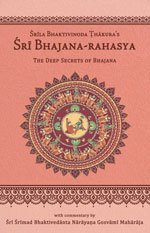Bhajana-Rahasya
by Srila Bhaktivinoda Thakura Mahasaya | 2010 | 123,965 words
The Bhajana-rahasya Text 13, English translation, including commentary (vritti). The Bhajana-rahasya is a compilation of verses describing the mercy of the eight pairs of names (Yugala-nama) of the Maha-mantra. This is text 13 belonging to the chapter “Prathama-yama-sadhana (Nishanta-bhajana–shraddha)” representing the last six dandas of the night: approximately 3.30 a.m.–6.00 a.m.
Text 13
The path of aṣṭāṅga-yoga is always full of fear. Śrīmad-Bhāgavatam (1.6.35) states:
यमादिभिर् योग-पथैः काम-लोभ-हतो मुहुः
मुकुन्द-सेवया यद्वत् तथाद्धात्मा न शाम्यतिyamādibhir yoga-pathaiḥ kāma-lobha-hato muhuḥ
mukunda-sevayā yadvat tathāddhātmā na śāmyatiThe mind that is disturbed by the enemies of lust, anger, greed and so forth does not become as subdued or peaceful by practising yama and niyama on the path of aṣṭāṅga-yoga as it does by performing service to Śrī Mukunda, which brings it completely under control.
योगे शुद्ध करि’ चित्ते एकाग्रह करे
बहु-स्थले ए कथार व्यतिक्रम धरेyoge śuddha kari’ citte ekāgraha kare
bahu-sthale e kathāra vyatikrama dhare
Commentary: Bhajana-rahasya-vṛtti:
In Śrī Caitanya-caritāmṛta (Madhyalīlā 22.29) it is stated:
ज्ञानी जीवन्-मुक्त-दशा पाइनु करि’ माने
वस्तुतः बुद्धि ‘शुद्ध’ नहे कृष्ण-भक्ति बिनेjñānī jīvan-mukta-daśā pāinu kari’ māne
vastutaḥ buddhi ‘śuddha’ nahe kṛṣṇa-bhakti bine
This verse describes how yogīs observe the practices of aṣṭāṅgayoga [1], such as yama and niyama, in order to restrain their senses. They use processes like prāṇāyāma to pacify the restless mind, and they use pratyāhāra to keep the objects of sense enjoyment far away. By remembering their object of meditation, by repeated dhāraṇā, and finally by samādhi, they become absorbed in brahma, which is devoid of transcendental pastimes. Although they go through many dif ficulties and although they practise so much self-control, even if they are successful, they only attain a degraded state. The heart of the living entity cannot become completely pure by performing such yoga, for upon seeing the forms and tasting the objects that attract his senses, he again becomes agitated to attain them. It is because of that desire that he falls down. Examples of this are Maharṣi Viśvāmitra and Saubhari Muni.
The purity desired by the practitioner of aṣṭāṅga-yoga is autom atically manifest in the devotee who performs bhakti-yoga; it naturally comes to the devotee on the strength of bhakti. In bhakti-yoga, the devotees, who are fearless, free from care and sorrow, and without worldly desires, are engaged in the service of Mukunda. Śrī Mukunda, being pleased by their unalloyed devotion, protects and maintains them under all circumstances.
Footnotes and references:
[1]:
Please refer to aṣṭāṅga-yoga in the Glossary for an explanation of the related terms that appear here.
